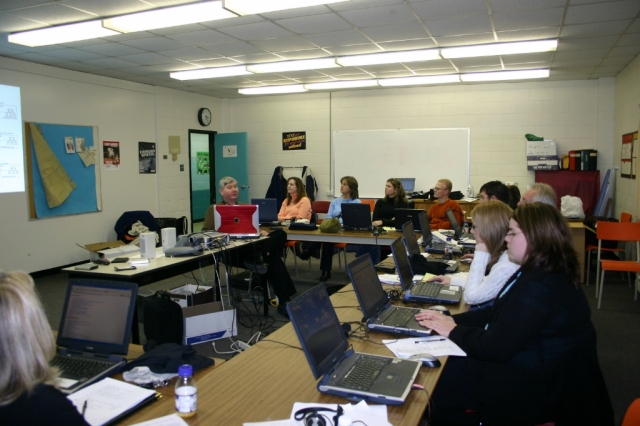The CDLI’s implementation procedures depend, to a fair extent, on support from people at the school where the students are located. In the original pilot we worked with the concept of an mTeacher (mediating teacher) being one of the school’s teachers located onsite and who would also help out with the implementation. We imagined the role as consisting of providing basic support such as the supervision of tests and ensuring that students were adequately monitored while online.





During the spring, near the end of the pilot year I held a series of focus groups attended by the principals and mTeachers for the pilot. Doug Furey, who was serving as a program specialist assisting with the pilot in one of the districts and who was also completing his Masters of Education was visiting Memorial at the time and also asked if he could sit in on the meetings.
After the meetings got underway it became clear that not only had much been learned along the way but, much remained to be learned. To say the least, those meetings were enlightening, bringing forward problems, and as it turned out, solutions to many of them. One thing that became apparent was the range of tasks that the school found itself having to deal with. These included:
- Selecting students for the courses and getting them registered.
- Ensuring that appropriate space in the school was provided for the students when they were online. Regardless of whether this was part of the F2F class or a whole different room, the students needed a place.
- Liaising with CDLI; learning what was up and what was new.
- Supervising tests and labs.
- Ensuring that students were on task
- Communicating with eTeachers whenever there was an issue with Teaching and Learning that was affecting the students.
- Providing basic training on how to get online for the first time and on how to use the tools.
- Providing onsite tech. support. This included things like preparing trouble tickets regarding connectivity downtime, boxing up damaged equipment and unpacking and then setting up replacement equipment.

I recall that time like it was today! I took notes of what was required on a flipchart or a whiteboard and after the list was complete it was similar to the one above but in a different order. One of the principals remarked that it was an onerous one and that eLearning at the school did come at a cost. The principal went on to say, though, that this was not to be negative—the tasks got done but we really needed to find a more organized way to do them. Another principal then followed up by noting that, based on the skills of his available staff members he has actually farmed it out. Others then weighed in to say that they had done essentially the same. Together then we looked at the required tasks and looked to classify them. The list above is fairly close to the one we wound up with in the end and based on it, Doug Furey suggested that we actually stop thinking in terms of mTeachers and, instead, focus on mTeams. That was it! With that said it all became so obvious and we quickly came up with a working description of what comprised an mTeam. It had four components.
- Administration: Typically done by the principal or designate, this consisted roughly of tasks 1-3 above, namely registering and selecting students and ensuring that they had an adequate, supervised space.
- Coaching: Typically done by an onsite teacher this consists of tasks 4-6, namely student supervision and liaising with the eTeachers as needed.
- Peer Support: Typically done by a more senior fellow student, this included some aspects of coaching as well as the basic training.
- Technical: Typically done by the district technicians with help from onsite student tutors.
In subsequent years CDLI embarked on a series of mTeam training sessions. These were done for new schools and, periodically, to refresh existing schools as personnel sometimes moved on and besides, the procedures and tools were evolving anyway. These were generally held on regional basis in district offices and were attended by Frank, Bob, Me, the nearby eTachers and some of the district’s technical staff and program specialists.





Not only did these serve as valid conduits of information from CDLI to onsite staff but, just as importantly, the flow of information was two-way and mTeam training sessions often resulted in the unearthing and subsequent solving of issues.
Next: Other technologies and abilities have been added along the way. We’ll look at how video and videoconferencing has been layered in.

I’m really impressed by your eLearning approach, great use of technology and beautiful, beautiful country. I can see why the folks who live at Black Tickle wouldn’t want to move away and if the young people have access to education and learning opportunities in just the same way as urban kids then in my mind they get the best of all worlds. If it’s possible to be homesick for somewhere you’ve never been then this is it.
We who live here are a bit of a different breed–we are ‘of’ this place. We have all struggled hard to make lives here and are willing to make sacrifices to keep it. Something, Tracy, you know a thing or two about…
I’m in awe of you, you are a true example of humanity and community at its best. I raise my hat to you all.
You demonstrate in this post the flexibility and adaptability of the CDLI team. I believe those two characteristics (along with a generally high level of smarts and persistence) of the working group ensured your success. Also … I really like the pictures of the rural outposts served by CSLI. Although I enjoy the faces of the team members … the two at the very top of your post are really nice. I think the second should be on cover of the book! D
Dana Griffiths, one of our chemistry teachers, took those pictures on a visit a few years back when she made a site visit to get some labs done. She took others and one just like #2 is the desktop background on her computer at work! You are right–flexibility is really key here. People who expect things to be done ‘one correct way’ would have a very hard time with our way of working. We have 1000 students taking courses from us in 103 schools. That’s 1000 personalities, each with their own story, skills, interests and ways of learning. In the end, they learn a fair bit of self-discipline but we have to be very flexible in order top get things to work.
I like the praggmatic and sensible approach. Seems jargon free and those four key points seem like the essentials were covered without coming out with a load of drivel (unless you didn’t bother posting that!)
LOL! Perhaps there was drivel too but in the environment I work in it would soon, thankfully, be killed off :>)
Pingback: History Of K-12 Distance Education In Newfoundland And Labrador | Virtual School Meanderings